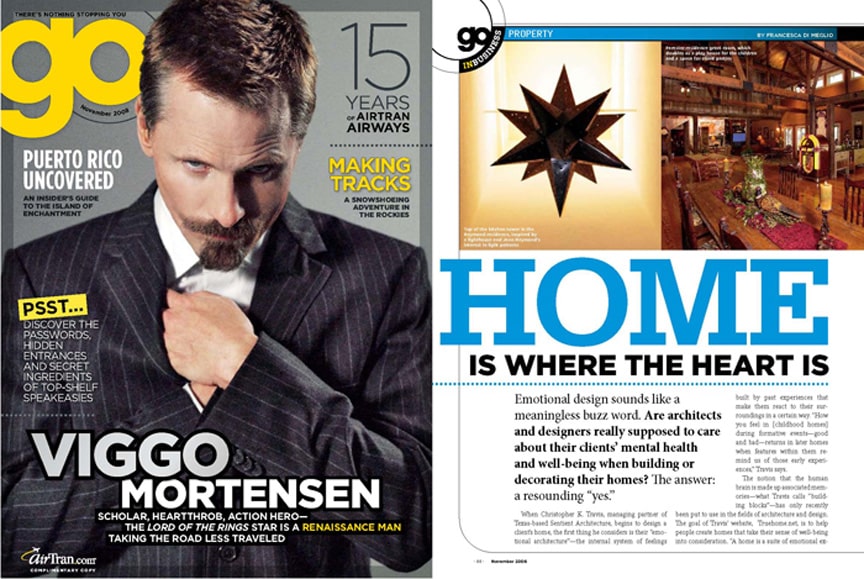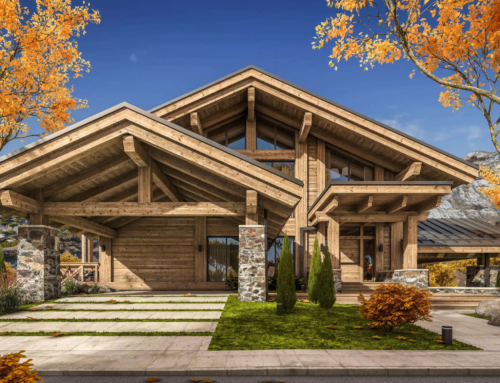By Christopher K. Travis
(First published in 2000)
What is it that makes a house a home? Do bricks and boards create a room that is comfortable and inviting? Is relaxation a result of finding the right paint color? Does that feeling of being safe and protected come from the choice of wall covering or is it a result of the finish hardware?
These questions seem frivolous on the surface, but after twenty-five years of helping people design, build and remodel their homes, I’ve become convinced that understanding the “emotional architecture” a client brings to a project is a critical part of designing a house that feels like a “home.”

The fact is, when most people decided to remodel their home or build a new house…they lose their minds! That is a big problem for designers, because your clients’ “home” is actually a psychological set of attachments, most of which are subconscious.
It’s true. Stable marriages topple like palm trees in the hurricane of home improvement. Pleasant, cooperative homemakers turn into Machiavellian harpies, combating husbands who vow to fight to the death on the ramparts of their own financial Alamo. Practical, down-to-earth CPA’s suddenly realize they are the reincarnation of Frank Lloyd Wright. Customers lie about their budgets, trying to bargain with the designer as though they were buying their house from a Tijuana sombrero salesman.
Perfectly reasonable people, who would never dream of telling their doctor how to treat a disease or their lawyer how to draft their will, think nothing of telling a professional architect how to design their home.
Worst of all, when people begin the process of designing a new home, they forget the basic laws of economics. I long ago discovered that when customers who were over budget came to my office to “trim the fat,” they were actually going to add a Jacuzzi, upgrade the ceramic tile, change the plastic laminate counter tops to granite, and then expect the price to drop.
It set me to wondering.One day I experienced an epiphany. I was converting a group of historic buildings in Round Top into a country inn.
An Awakening
The Queen and my kids were still in Houston. Every Monday morning I drove up to Round Top and then drove home to Houston every Friday night. In between, I slept on an air mattress on the second floor of an old pier and beam house, one of several we were restoring.
Alone all week, I had plenty of time to think. In the evenings I would sit in an old rocking chair on the wood plank porch. I found myself inexplicably happy. Everything seemed right with the world as I rocked on that porch. I began to ask myself why…and before long I uncovered the source of my unexplained peace of mind.
I remembered a place from my childhood…, my great grandfather’s porch. I called him “Nandaddy.” I can still see him dressed in overalls, bending down to pick me up, a broad smile on his face. “Come hug my neck,” he would say.

Years later in 1992, the architectural features of a similar porch in Round Top brought back unconscious memories of that cherished time. I had discovered a key feature of my emotional architecture! Suddenly I understood why I kept returning to historic restoration work even though, truth be told, it was less profitable than my other building ventures.
I realized then that we all view the world through a broad set of internal associations most, but not all, from our childhood. This internal landscape determines how we respond emotionally to the architecture in our surroundings.
Eight years later, I lived in another old farmhouse. I felt happy and very much at home. Built in the 1840’s, the restoration was never really complete. The downstairs was cold in the winter and the upstairs a hothouse in the summer. Bugs find it easy to get in and the AC finds it easy to get out. The old place required constant maintenance.
You would think these things would have been annoying, but I sat on my porch in the evenings and think about how lucky I am. You see, it wasn’t just an old German farmhouse to me. It was the place I raised my two youngest children. Those old walls held the accomplishment I felt at having been able to leave the big city and make a new home in the country. My best girl slept there in a bed I made with my own hands. It was a place filled with memories of all the good times I’d had with the people I love. I came to realize that these emotional associations are the actual bricks and mortar of my experience of “home.”
Home Is In Your Head
It’s obvious if you think about it. A robin takes great care to build a nest and guards it jealously until her chicks have flown away. Then, that cherished nest is just another pile of sticks. We humans are not that much different. A house is a material object. A “home” is of the heart.When people are looking for a new living space, they are really looking for how that new space “feels,” and how well it fits the day to day reality of their lives, and the values that are important to them.
With this key realization guiding the way, I began to seek a technology to uncover the features of my clients’ emotional architecture. It seemed to me, that if a designer could uncover the emotional associations of his client, he would discover powerful clues to a design that would create that illusive and individual experience we call “home.”
Now, years after I had that first realization, I am finally approaching my goal. The human mind is complex, and my skills and training are limited, but after years of research and working with clients, I have developed a systematic process that combined psychological testing and architectural programming in a way that actually identifies what specific features of a house inspire an individual or a family to “feel at home.”

What exactly is the advantage of knowing for yourself what features of a building or a location will inspire you to feel at home?
In his book, The Timeless Way of Building, Christopher Alexander says “The specific patterns out of which a building or a town is made may be alive or dead. To the extent they are alive, they let our inner forces loose, and set us free; but when they are dead they keep us locked in inner conflict.”
Mr. Alexander’s theory says that architecture gains aliveness by reflecting the patterns of behavior of those who inhabit it. In other words, the day to day repetitive actions, events and activities of human beings, naturally organize space in a way that is healing and nurturing. When those patterns are ignored, he suggests, we have the type of architecture that now fills our cities…dead, mechanical boxes, impersonal and cold.
If is possible, as Mr. Alexander believes, to bring humanity to architecture�then it seems to me that the unconscious world of emotion that lives within us must be a primary source for much of our design criteria.
In our firm, we make it clear to our clients that a successful design is the result of a good partnership between the designer and the client. My partner and I may know a lot more about architecture and construction than our customers, but our clients are the experts on their own values, tastes, lifestyle and budget.
Time and again however, we find that clients approach us with a broad set of assumptions about cost and design, assumptions that are often poorly grounded in fact. These misconceptions tend to color their requests, often causing them to misrepresent their needs and desires. In other words, people think they know what they want, but are often wrong about how their choices will male them feel or match their deeper sub-conscious needs.
Over time we have found it important to serve as a “devil’s advocate” and challenge our clients’ preconceived ideas if we were to truly discover their most basic priorities. It soon became obvious to us that if we were sincere about trying to get at these deeper issues within our customers, and not just impose our own design ideas on them, we would have to take them on a journey of discovery.
Each person has a unique relationship with the aesthetics of space and form based on a number of factors, most of which are unconscious and purely emotional. If these items can be identified, and included in their design, they feel psychologically more at home in their new space.
The reason we believe this is that modern neuroscience has effectively proven it to be true.






